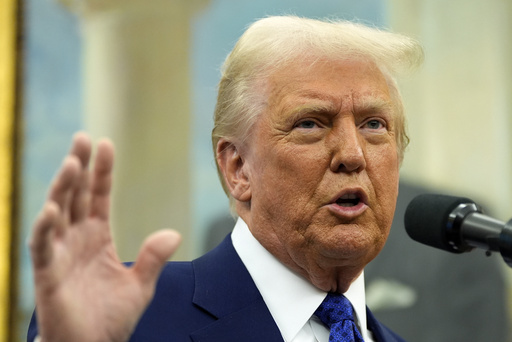
WASHINGTON — During his campaign last year, Donald Trump asserted his ability to swiftly curb inflation and alleviate concerns regarding the economy. At a rally in California, he claimed, “I will very quickly deflate,” adding that he would “defeat inflation” and take decisive action against it.
However, recent data from the consumer price index indicates that inflation is resurging, presenting challenges that could mirror those faced by his predecessor, Joe Biden. In the three months following November’s election, the annual inflation rate has surged to 3%, with gasoline prices rising contrary to Trump’s assurances that his potential return to the presidency would lead to increased oil production and lower energy expenses.
Trump has a history of making bold promises about his influence over economic change, but these declarations often fall short against the realities of market dynamics. It serves as a reminder that even a sitting U.S. president cannot control the market forces of supply and demand but must instead navigate through them.
Public sentiment appears to reflect skepticism about Trump’s proposed plans to expand tariffs as a means to combat inflation. On Wednesday, he urged for cuts to interest rates, despite the fact that previous rate increases by the Federal Reserve effectively helped reduce inflation that had peaked at a 40-year high in 2022.
Economists and financial markets are increasingly concerned with the latest consumer price data, which suggests that robust consumer spending, strong job creation, and a declining unemployment rate could reignite inflation. Continued demand, particularly from affluent consumers, enables companies to increase prices more easily.
Last month, the prices of various goods—including toys and automobile parts—rose even before new tariffs were implemented. Trump recently established a 10% tariff on Chinese imports and has also announced the elimination of certain exemptions related to his 2018 tariffs on steel and aluminum. Furthermore, he is considering potential tariff hikes on Canada and Mexico, as well as an executive order to raise tariffs to match import taxes imposed by other nations.
As a result, the baseline pressures of inflation could reach their highest levels in decades. Joseph Brusuelas, chief economist at a tax and advisory firm, remarked, “Disinflation may be dead, and we may be looking at a higher rate of inflation than we observed for the 20 years prior to the pandemic.”
Trump’s call for reduced interest rates conflicts with the stance of Fed Chairman Jerome Powell. During a congressional committee meeting on Wednesday, Powell stated, “If inflation goes up in general, we will use our tools, which is the interest rate, to bring it back down to 2% over time,” also indicating that Trump’s recommendations would not influence the Fed.
Up to this point, the primary strategy from Trump’s administration in managing inflation has been to attribute blame to Biden, but that narrative may soon lose relevance as Trump gains more control over economic strategies. White House Press Secretary Karoline Leavitt noted in a news briefing, “The Biden administration indeed left us with a mess to deal with. It’s far worse than I think anybody anticipated.”
At the same time, some of Trump’s allies are proposing novel strategies to combat inflation. Elon Musk, the head of Trump’s Department of Government Efficiency, suggested a radical $1 trillion spending cut this year while standing in the Oval Office on Tuesday. Musk, recognized as the world’s wealthiest individual and the chief of firms including Tesla and SpaceX, believes that eliminating $1 out of every $7 spent by the federal government could drop the inflation rate to zero. However, due to ongoing lawsuits and the complex nature of congressional funding, it’s uncertain whether Musk can achieve such savings.
He asserted, “If you cut the budget deficit by a trillion between now and next year, there is no inflation,” indicating that this would also affect interest costs, leading to lower payments across various loans for consumers. While such substantial cuts could potentially decrease prices, they could also precipitate a severe economic downturn.
Michael Linden, a senior policy fellow at the Washington Center for Equitable Growth, cautioned, “That would be a roughly 4% of GDP cut to federal spending, all in one year. It would be an instant recession.”
In the meantime, investors are bracing for more inflation as consumer demand remains robust, and Trump has yet to clarify how his strategies might effectively lower prices, as he promised voters. The yield on the 10-year Treasury note climbed to 4.62% on Wednesday following the inflation report, signifying investor expectations of elevated interest rates, growth, and inflation in the future.
Shopper sentiment also signals an expectation of rising inflation; the University of Michigan’s consumer sentiment survey indicates that Americans now foresee an inflation rate of 4.3% for the current year, up from 3.3% the prior month, with many respondents citing tariff concerns.
When asked about the potential effectiveness of Trump’s call for reduced interest rates in curtailing inflation, Leavitt emphasized the president’s desires rather than outlining specific policy actions. She noted, “He wants interest rates to be lower. He wants inflation to be lower. And he believes that the whole of government economic approach that this administration is taking will result in lower inflation.”

